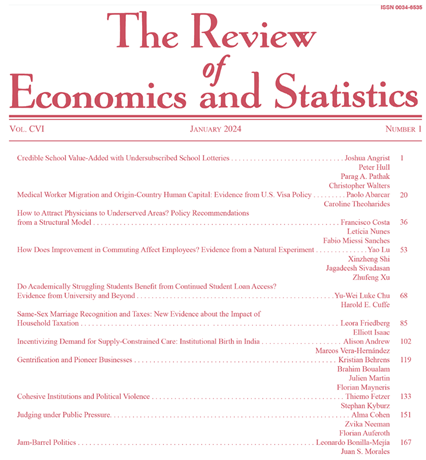Comparative Cross-Country Analysis of the Development Level of Scientific and Innovative Activity
IF 6.8
1区 经济学
Q1 ECONOMICS
引用次数: 0
Abstract
The progressive economic development of countries in the modern world is based on the corresponding development of scientific and innovative activities. The paper analyzes the main indexes characterizing the state of scientific potential and indexes reflecting the effectiveness of scientific activity in 43 countries of the world, including Russia and China. Interrelations of indexes are revealed and regression equations describing the existing dependencies are constructed. Based on the obtained models, the results of scientific activity are estimated for two countries: Russia and China. The estimates are compared with the actual levels of indexes and conclusions are drawn about the effectiveness of the use of available scientific resources.Purpose of the study. The aim of the study was to identify homogeneous groups of regions that are similar in their economic and innovative indexes, statistical analysis of these groups based on non-parametric methods and methods of correlation and regression analysis, and the formation of conclusions and recommendations regarding their innovative activities.Materials and methods. The following statistical methods were used in the study: non-parametric, correlation-regression, multivariate classifications (cluster analysis), discriminant analysis, descriptive statistics (averages, structural averages, variation indexes, etc.). The work used the statistical data of the World Bank, OECD, Rosstat. The calculations were carried out using the STATISTICA 12.0 software package.Results. The paper classifies countries according to the level of scientific potential and scientific performance. The cluster affiliation of Russia is determined. The search for a circle of countries that have similar conditions of scientific potential with Russia for further use of the experience of these countries is one of the goals of the paper. As a result of the analysis, it can be noted that the inventive activity of the Russian population is quite high, at the same time, the scientific potential in relation to scientific publications is used extremely poorly. In China, high levels of inventive activity and average citation of scientific publications can be noted. The number of patents granted, taken as a whole, has a strong linear relationship with GDP per capita and a strong non-linear relationship with domestic spending on research and development as a percentage of GDP and the number of people employed in research and development per 10,000 employed in the economy. By cluster groups, the listed dependencies were not found in the developed countries included in the first cluster, but were confirmed for the other of the countries.Conclusion. An analysis of the inventive activity of the Russian population showed that, with the existing scientific potential, the country managed to achieve much better results in this area than it could be based on the values of per capita GDP, research and development costs, the number of personnel, etc. (the excess according to different models is approximately 1.4 - 2.7 times). In general, for the totality of countries, the citation rate has a sufficient relationship with GDP per capita and the number of staff involved in research and development, but the volume of internal costs per researcher and the share of internal costs as a percentage of GDP do not significantly affect it. The experience of China confirms this conclusion: with a low cost per researcher, the country managed to achieve high results in the innovation field, but this phenomenon can be explained by the existence of a certain lag between the development of indexes. Separately, for cluster groups that divide the entire set of countries into highly developed, underdeveloped and countries occupying an intermediate position, no relationship was found between the citation index and other indexes.This paper is focused, first, on specialists dealing with the problems of the development of science, in particular Russian. The established relationships between indexes characterizing the level of scientific potential and scientific performance, described using linear and non-linear models, will help practitioners who decide on the organization and financing of science to find the best ways to solve emerging problems.科技创新活动发展水平的跨国比较分析
现代世界各国经济的进步发展是以科学和创新活动的相应发展为基础的。本文分析了包括俄罗斯和中国在内的43个国家的科学潜力状况的主要指标和反映科学活动有效性的指标。揭示了指标间的相互关系,构造了描述现有依赖关系的回归方程。根据获得的模型,对俄罗斯和中国这两个国家的科学活动结果进行了估计。将估算值与指标的实际水平进行比较,得出现有科学资源利用有效性的结论。研究目的:研究的目的是找出经济和创新指标相似的区域同质群体,利用非参数方法和相关回归分析方法对这些群体进行统计分析,并形成关于其创新活动的结论和建议。材料和方法。本研究采用了以下统计方法:非参数、相关回归、多元分类(聚类分析)、判别分析、描述性统计(平均值、结构平均值、变异指数等)。这项工作使用了世界银行、经合组织、俄罗斯统计局的统计数据。使用STATISTICA 12.0软件包进行计算。本文根据科学潜力和科学绩效的水平对国家进行了分类。俄罗斯的集群隶属关系确定。寻找一个与俄罗斯具有相似科学潜力条件的国家圈,以进一步利用这些国家的经验是该论文的目标之一。根据分析,可以指出,俄罗斯人口的发明活动相当多,与此同时,与科学出版物有关的科学潜力利用得非常少。在中国,可以注意到高水平的发明活动和科学出版物的平均引用。专利授权数量作为一个整体,与人均GDP有很强的线性关系,与国内研发支出占GDP的百分比和经济中每万名就业人员中从事研发工作的人数有很强的非线性关系。按聚类分组,在第一组的发达国家中没有发现所列的依赖关系,但在其他国家中得到了证实。对俄罗斯人口的发明活动的分析表明,凭借现有的科学潜力,该国在这一领域取得了比根据人均国内生产总值、研究和开发费用、人员数量等价值(根据不同的模型,超额量约为1.4 - 2.7倍)所能取得的成果要好得多。总的来说,对于所有国家来说,被引率与人均GDP和参与研究开发的工作人员数量有充分的关系,但每位研究人员的内部成本量和内部成本占GDP的比例对被引率没有显著影响。中国的经验印证了这一结论:在人均成本较低的情况下,国家在创新领域取得了较高的成果,但这种现象可以用指标发展之间存在一定的滞后性来解释。另外,对于将整个国家划分为高度发达国家、不发达国家和处于中间位置的国家的聚类组,引文指数与其他指标之间没有关系。本文首先关注的是处理科学发展问题的专家,特别是俄罗斯的专家。利用线性和非线性模型描述表征科学潜力水平和科学绩效的指标之间建立的关系,将有助于决定科学组织和资助的实践者找到解决新出现问题的最佳方法。
本文章由计算机程序翻译,如有差异,请以英文原文为准。
求助全文
约1分钟内获得全文
求助全文
来源期刊

Review of Economics and Statistics
Multiple-
CiteScore
8.50
自引率
0.00%
发文量
175
期刊介绍:
The Review of Economics and Statistics is a 100-year-old general journal of applied (especially quantitative) economics. Edited at the Harvard Kennedy School, the Review has published some of the most important articles in empirical economics.
 求助内容:
求助内容: 应助结果提醒方式:
应助结果提醒方式:


